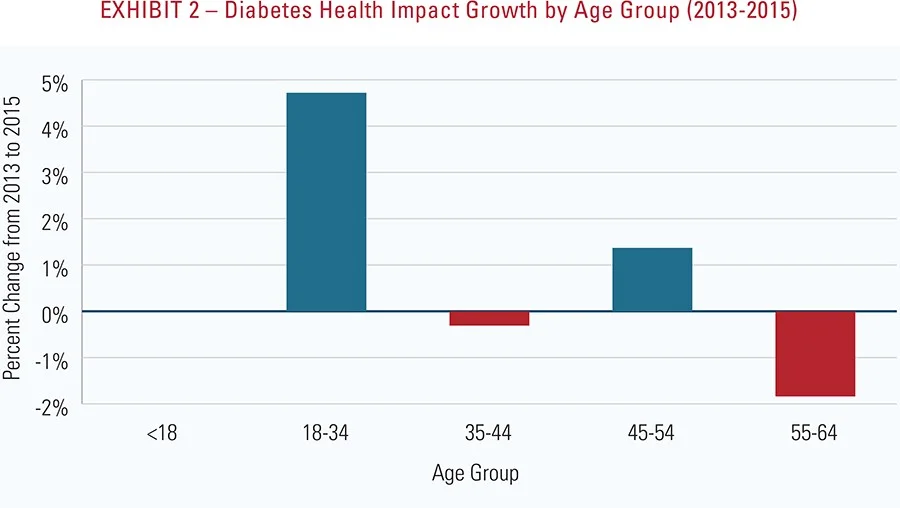Blue Cross Blue Shield Association study shows increased diagnosis of type 2 diabetes in young adults
By: Grace Derocha, registered dietitian, certified diabetes educator and health coach at Blue Cross Blue Shield of Michigan
November, also known as “National Diabetes Month,” serves as a time to educate people of all ages on how to better manage the risk for diabetes and encourage those living with the disease to learn more about how they can lead the healthiest and happiest life possible.
Metro Detroit is home to more than 121,000 Arab Americans, the world’s largest population outside of Iraq. When looking at the health conditions most commonly affecting this group of people, a study by the National Health Interview Survey found an overall diabetes prevalence of 15.5 percent in women and 20.1 percent in men, in addition to a reported lower level of selfcare by diabetic patients.
Overall, the Blue Cross Blue Shield Health Index-generated ‘Diabetes and the Commercially Insured U.S. Population’ study found diabetes accounts for more than nine percent of the total health impact of conditions affecting individuals within the 18-34 age group. Looking at the health implications of diabetes compared to over 200 health conditions, the study connects this illness to age, obesity trends and region. Individuals in the 18-34 age range experienced nearly a five percent growth of Type 2 diabetes diagnoses, making it the largest increase among all the age groups. Unfortunately, the rise in diagnoses can be explained when looking at the eight percent increase in obesity in the same age group.
The link between diabetes and obesity can be known as ‘diabesity’, meaning the two health conditions are associated with one another. In a study by the National Institutes of Health, 46.2 percent of Chaldeans in metro Detroit were considered overweight, while 30.3 percent were considered obese. For the Arab American population, these numbers are 52.2 and 28.5 percent, respectively. It is important to remember that Type 2 diabetes is a commonly preventable chronic condition impacted by an individual’s lifestyle habits. For this reason, it’s vital for individuals to know the difference between the uncontrollable and controllable risk factors that contribute to these diagnoses.
Among the list of risk factors associated with this disease, those that are uncontrollable include age, gender, race, genetics and family medical history. Conversely, there are many risk factors that are manageable:
· Find a Support System: Finding motivation to develop healthier habits alone can be challenging. Recruit a team of health care experts, family members and friends to set lifestyle goals together and keep each other accountable.
· Eat Healthy, Watch Portions: A balanced, nutritious diet helps maintain glucose levels and can aid in accomplishing weight loss goals. Incorporating healthy portions of fruits, vegetables, whole grains, lean proteins and heart healthy fats into a diet is essential for managing the risk of Type 2 diabetes. Note that yo-yo dieting impacts the body’s ability to sustain healthy blood sugar levels and the goal should never be to eliminate any food group from a meal plan. Overweightness and obesity are the most controllable risk factors to prevent a type 2 diabetes diagnosis.
· Get Moving: Exercise not only helps an individual lose weight and gain muscle, but lowers and stabilizes blood sugar levels and boosts the body’s ability to use insulin properly. Adults should aim for at least 30 minutes of physical activity a day, five days a week, which should include both cardiovascular exercise and resistance training.
· Get Rest: Americans today get 40 percent less sleep than the body needs to function at its best. Chronic sleep deprivation can lead to weight gain, high blood sugar and hormone imbalance. The job of insulin is to help the body use glucose (sugar) for energy. Insulin is a hormone. When the body is showing signs of insulin resistance, that means the body’s cells cannot use the insulin hormone efficiently, it can result in higher blood sugar. Adults should aim for seven to nine hours of shut-eye per night.
· Stress Less: According to the American Diabetes Association, long-term stress can cause long-term high blood glucose levels. Managing stress is different for every individual; exercising, meditation and deep-breathing exercises are a few ideas to explore.
· See the Doctor: Establishing a relationship with a primary care physician or an endocrinologist can help an individual manage their risk for developing Type 2 diabetes and help those living with the condition to receive necessary health assessments and care.
For individuals that have already been diagnosed with Type 2 diabetes, it’s important to regularly visit a primary care physician and take medications as prescribed.
To read the full report, click here. For more information on maintaining Type 2 diabetes visit www.mibluesperspectives.com.


